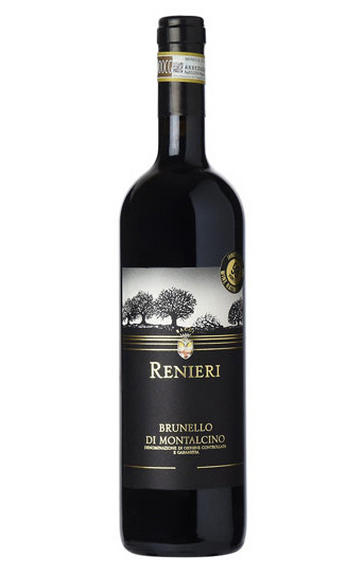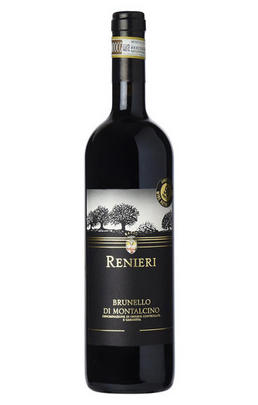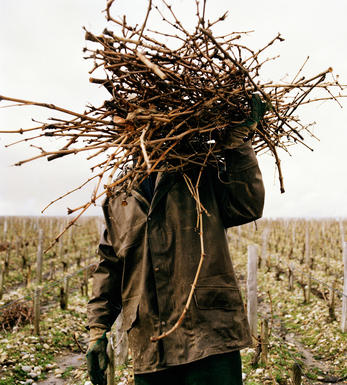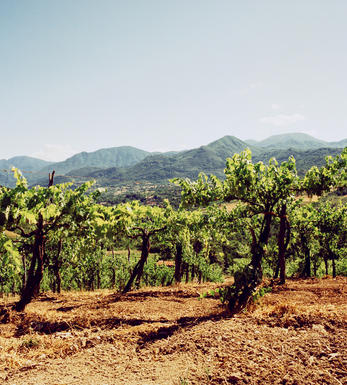
2015 Brunello di Montalcino, Renieri, Tuscany, Italy

Critics reviews
The Renieri 2015 Brunello di Montalcino is dark and intense in its aromatics, displaying a mix of earthy mineral and soil tones, offset by crushed black cherry, savoury herbs, leather, and spice. On the palate, soft, fleshy textures usher in ripe cherry fruits, offset by a mix of brisk acids and saturating minerals, as hints of exotic spice buzz upon the senses, leaving a coating of fine tannin in their wake.
The finish is long and structured, flexing its hulky tannins, as only a hint of dried black cherry, minerals, and spice linger. The 2015 Renieri needs time and lots of it, but I believe its primary fruit and acids will one day tame the massive structure that is currently dominating the wine’s personality.
Drink 2026 - 2036
Eric Guido, Vinous.com (April 2020)
The Renieri 2015 Brunello di Montalcino takes a slightly different read of the vintage, with drier and more austere fruit flavours. I get some tannic astringency as well on the finish with a point of bitterness. Compared to many of its peers that produced soft and richly opulent wines in the warm 2015 vintage, Renieri's expression is a bit more angular and edgy. You get dark fruit tones with sour cherry and spice on the close. One thing it does share in common is that balsamic aromatic intensity that you encounter so readily in Brunello from the classic 2015 vintage.
Drink 2021 - 2035
Monica Larner, Wine Advocate (January 2020)
Earthy aromas of bark, sand, truffles, graphite, rust, terracotta and sandalwood rise up from the deep with Burgundian poise; fruitier orange zest and preserved lemons glimmer in their wake, while riper incense and tar lurk in this dense forest of aromas. Physics itself gives way as the line between reduction and oxidation is blurred.
There’s such richness to the centre palate, but the fruit there is vivacious and elegant, swaddled in robust but generous tannins that breach the outermost reaches of the mouth. The finish is hauntingly long, the aftereffects of the acidity unworldly. This is certainly in a quiet, reserved stage of evolution, and will need time to fully mature in bottle.
Drink from 2025
James Suckling, JamesSuckling.com (September 2020)
In the eastern sector of the Montalcino region, Renieri's vineyards sit between 300-350 metres above sea level in a relatively cool area. The soil is volcanic with deposits from the nearby Monte Amiata. Discreetly perfumed, the nose is earthy and cedary in character. This is medium-weight with upfront, chewy tannins that stop just short of drying. It has a distinctive flintiness on the palate and finishes with bloody nuances.
Drink 2021 - 2030
Michaela Morris, Decanter.com (February 2020)
About this WINE

Renieri di Montalcino

Brunello di Montalcino
Along with Chianti, Brunello di Montalcino is Tuscany's most famous DOCG and the region's boldest expression of Sangiovese. Located 30 miles south of Siena with the hilltop town of Montalcino as its epicentre, its 2,000 hectares of vines are naturally delimited by the Orcia, Asso and Ombrone valleys. Brunello is the local name for the Sangiovese Grosso clone from which Brunello di Montalcino should be made in purezza (ie 100 percent).
The Brunello di Montalcino DOCG has a whale-like shape: at its head, at 661 metres above sea level on ancient, stony galestro soils facing east and southeast lies the town of Montalcino, where the DOC was founded. As you follow the spine south towards the tail, the vineyards lose altitude – those around Colle Sant'Angelo are at 250 metres – while the soils become richer with iron and clay. Further east, in the shadow of the 1,734 metre Mont'Amiata lies the village of Castelnuovo dell'Abate where the vineyards are strewn with a rich mix of galestro, granitic, volcanic, clay and schist soil types.
Historically, the zone is one of Tuscany's youngest. First praised in 1550 by Leandro Alberti for the quality of its wines, it was Tenuta Il Greppo who bottled the inaugural Brunello di Montalcino in 1888. By 1929, the region had 925 hectares of vines and 1,243 hectares of mixed crops, while in 1932 it was decreed that only those wines made and bottled within the commune could be labelled as Brunello di Montalcino. Since then, the number of producers has risen from 11 in 1960 to 230 in 2006, while over the same period the vineyards have expanded from 1,000 hectares to 12,000. The region earned its DOC in 1966, and was upgraded to DOCG in 1980.
Brunello di Montalcino cannot be released for sale until five years after the harvest, or six years in the case of Brunello di Montalcino Riserva. During this time the wines should be aged for at least two years in oak, followed by at least four months in bottle (six months for Riservas); maximum yields are 55 hl/ha.
Rosso di Montalcino is declassified Brunello di Montalcino, released for sale 18 months after the harvest.
Recommended producers: Costanti, Fuligni, Lisini, San Giuseppe, Soldera, Cerbaiona

Sangiovese
A black grape widely grown in Central Italy and the main component of Chianti and Vino Nobile di Montepulciano as well as being the sole permitted grape for the famed Brunello di Montalcino.
It is a high yielding, late ripening grape that performs best on well-drained calcareous soils on south-facing hillsides. For years it was blighted by poor clonal selection and massive overcropping - however since the 1980s the quality of Sangiovese-based wines has rocketed upwards and they are now some of the most sought after in the world.
It produces wines with pronounced tannins and acidity, though not always with great depth of colour, and its character can vary from farmyard/leather nuances through to essence of red cherries and plums. In the 1960s the advent of Super Tuscans saw bottlings of 100% Sangiovese wines, as well as the introduction of Sangiovese/Cabernet Sauvignon blends, the most famous being Tignanello.


Buying options
Add to wishlist
Description
Earthy aromas of bark, sand, truffles, graphite, rust, terracotta and sandalwood rise up from the deep with Burgundian poise; fruitier orange zest and preserved lemons glimmer in their wake, while riper incense and tar lurk in this dense forest of aromas. Physics itself gives way as the line between reduction and oxidation is blurred.
There’s such richness to the centre palate, but the fruit there is vivacious and elegant, swaddled in robust but generous tannins that breach the outermost reaches of the mouth. The finish is hauntingly long, the aftereffects of the acidity unworldly. This is certainly in a quiet, reserved stage of evolution, and will need time to fully mature in bottle.
Drink from 2025
James Suckling, JamesSuckling.com (September 2020)
wine at a glance
Delivery and quality guarantee